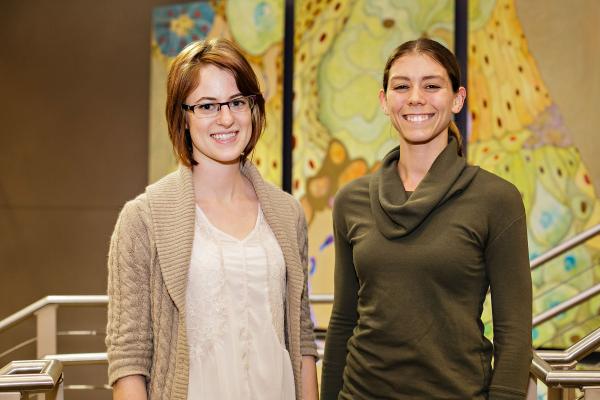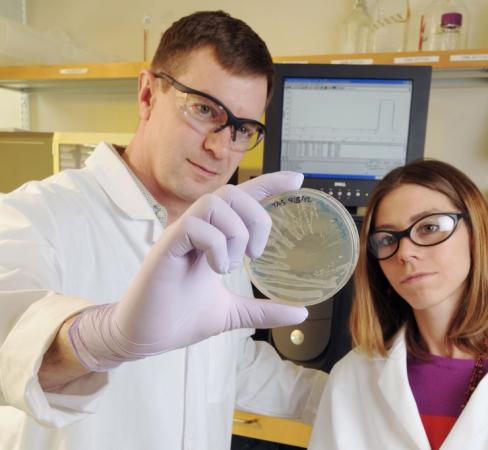Scientific research isn’t easy. It’s not supposed to be. For bright, confident undergrads with high expectations, scientific research can be particularly daunting because it means they have to dip their brains into the murky unknown to find answers no one else has discovered yet – answers that may elude them in experiment after experiment, which can be really disappointing for the scholar who is used to acing tests and finishing near the top of the class.
So it helps to have a guide, someone who remembers the disappointment, who isn’t intimidated by the trial-and-error nature of research and experimentation, and who has come through on the other side, after swinging and missing, to finally connect with a significant discovery or answer – someone like Ashley Brown. As a mentor in the Petit Undergraduate Research Scholar program, it’s her job to help one of the undergrad scholars, Kaitlin Ahlstedt, find that connection. In a sense, this is Brown’s way of paying it forward.
“One of the main reasons I was interested in being a mentor is, I had the experience of working with a mentor when I was an undergrad, and it was instilled in me how important this kind of mentoring program can be,” says Brown, a research scientist who has served a joint postdoctoral fellowship, in the labs of Tom Barker (associate professor in the Wallace H. Coulter Department of Biomedical Engineering) and Andrew Lyon (former professor in the School of Chemistry and Biochemistry, now dean of the Schmid College of Science and Technology at Chapman University in California).
While pursuing her Bachelor of Science in Biosystems Engineering at Clemson (she graduated Magna Cum Laude in 2006), Brown got involved in an undergraduate research program at the Georgia Institute of Technology. Even though that research focused on microelectronics – definitely not her cup of chi – she was hooked on the idea of coming to Georgia Tech. The biomedical engineering Ph.D. program’s No. 2 ranking nationally, she says, made her decision a no-brainer. “Georgia Tech was always my top choice,” says Brown, who earned her Ph.D. in 2011.
Since coming to Tech, she has mentored nine undergraduate students in different capacities, so she’s seen the transformation over and over, and that experience by itself, she says, “is so rewarding. You work with excited undergrads, many of them getting their hands dirty in a lab for the first time, getting excited about the science, making discoveries and really contributing to serious research. It’s a mutually beneficial experience.”
Barker, who has worked with Brown in his lab for years, says, “she epitomizes, for me, what a good mentor really is. She provides really good, clear directions, has a strong focus in what she wants to accomplish, and understands that new students who have not been exposed to this kind of environment, or even some who have, require a breaking-in period. Because it can be an uncomfortable place for a lot of young students who are accustomed to being lectured to, given information, memorizing it, and then regurgitating it on the exam. Learning through failure is foreign to many of them.”
That concept, “learning through failure,” gets right back to the heart of what might be most challenging to undergrads like the Petit Scholars. Barker even has an essay on the subject taped to his office door. When his graduate students want to know his philosophy, he often tells them to read the essay, published six years ago in the Journal of Cell Science and written by former University of Virginia professor Martin Schwartz (now at Yale).
Entitled, The importance of stupidity in scientific research, the essay is important because, as Barker summarizes it, “in science, if you know all of the answers already then you’re in the wrong place. We’re supposed to be at the cutting edge, defining the new definitions. The article sums up nicely, I think, the challenge for a good mentor.”
The challenge is in knowing when to push, when to support, or even when to pull back and, as Barker puts it, “let them drive the car – at least in the driveway. If we are trying to groom these undergraduate students to become the best graduate students in America, or across the world, we need to push them intellectually, outside their comfort zone. But there also are times when a mentor has to be a cheerleader. We all hit some really low lows – experiments that don’t work, or don’t give you the results you expected.”
A good mentor, in other words, inspires in his or her mentee an ability to remain persistent, with blinders, so that they will become numb to failure – because some failure is inevitable if you’re working on the cutting edge. It takes a self-assured guide, someone with a deft touch and a good sense of direction to go along with the big science brain.
The Petit Scholars program brings one scholar together with one mentor for a year of research. Scholars typically choose a mentor based on their interest a mentor’s research. Brown and Ahlstedt (who is one of five Petit Scholars in the 2014 class supported by funds from Children’s Healthcare of Atlanta) are working in Barker’s lab, focusing on clotting dysfunction in neonatal patients who have undergone surgery for congenital heart defects. Working with Dr. Nina Guzzetta, an anesthesiologist with Children’s Healthcare and Emory Pediatrics, their long-term goal is to find better treatment options for these very young and fragile patients.
“Kaitlin and I hit it off and have similar research interests. Her main focus is to understand how neonatal clot structural and mechanical properties differ from that of adult clots,” says Brown, who sees the Petit Scholar program as mutually beneficial. “That’s the whole point. The hope is that all of the scholars will end up on a publication, or presenting at a conference. So it’s important, on my part, to cultivate a good working relationship, to serve as a guide, but also to establish expectations.”
Ahlstedt is meeting, or exceeding those expectations – she’ll be presenting her work at the National Biomedical Engineering Society Conference in San Antonio in October.
Barker expects that Brown will be a highly sought-after faculty candidate this year, her last as a postdoc, with a career in academia just ahead, she hopes. Brown isn’t sure where she’ll wind up, but wants her next role as a mentor to be part of her job as a faculty member somewhere.
“I’m not sure where that will be, but I’m applying now with the goal of starting a new position next fall,” she says. “I’m casting a wide net.”
Media Contact
Jerry Grillo
Communications Officer II
Parker H. Petit Institute for
Bioengineering & Bioscience
Keywords
Latest BME News
Jo honored for his impact on science and mentorship
The department rises to the top in biomedical engineering programs for undergraduate education.
Commercialization program in Coulter BME announces project teams who will receive support to get their research to market.
Courses in the Wallace H. Coulter Department of Biomedical Engineering are being reformatted to incorporate AI and machine learning so students are prepared for a data-driven biotech sector.
Influenced by her mother's journey in engineering, Sriya Surapaneni hopes to inspire other young women in the field.
Coulter BME Professor Earns Tenure, Eyes Future of Innovation in Health and Medicine
The grant will fund the development of cutting-edge technology that could detect colorectal cancer through a simple breath test
The surgical support device landed Coulter BME its 4th consecutive win for the College of Engineering competition.









